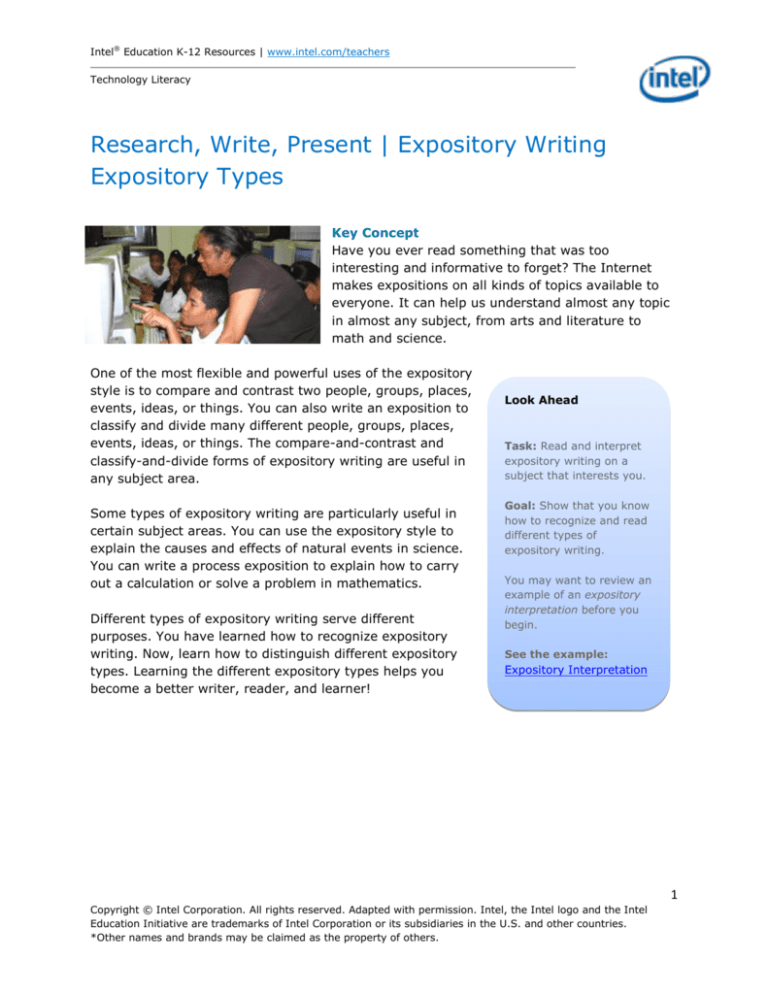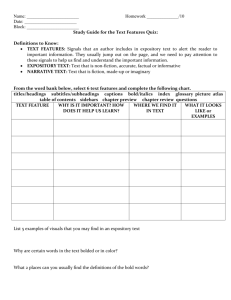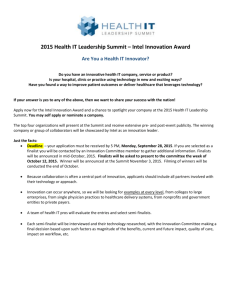
Intel® Education K-12 Resources | www.intel.com/teachers
Technology Literacy
Research, Write, Present | Expository Writing
Expository Types
Key Concept
Have you ever read something that was too
interesting and informative to forget? The Internet
makes expositions on all kinds of topics available to
everyone. It can help us understand almost any topic
in almost any subject, from arts and literature to
math and science.
One of the most flexible and powerful uses of the expository
style is to compare and contrast two people, groups, places,
events, ideas, or things. You can also write an exposition to
classify and divide many different people, groups, places,
events, ideas, or things. The compare-and-contrast and
classify-and-divide forms of expository writing are useful in
any subject area.
Some types of expository writing are particularly useful in
certain subject areas. You can use the expository style to
explain the causes and effects of natural events in science.
You can write a process exposition to explain how to carry
out a calculation or solve a problem in mathematics.
Different types of expository writing serve different
purposes. You have learned how to recognize expository
writing. Now, learn how to distinguish different expository
types. Learning the different expository types helps you
become a better writer, reader, and learner!
Look Ahead
Task: Read and interpret
expository writing on a
subject that interests you.
Goal: Show that you know
how to recognize and read
different types of
expository writing.
You may want to review an
example of an expository
interpretation before you
begin.
See the example:
Expository Interpretation
1
Copyright © Intel Corporation. All rights reserved. Adapted with permission. Intel, the Intel logo and the Intel
Education Initiative are trademarks of Intel Corporation or its subsidiaries in the U.S. and other countries.
*Other names and brands may be claimed as the property of others.
Intel® Education K-12 Resources | www.intel.com/teachers
Technology Literacy
Vocabulary
Words to Remember
This page gives basic definitions for some important terms that can help you learn about
types of expository writing. You can get a more complete definition of each term from Fact
Monster*.
New Words
Cause: A person, group, event, idea, action, or object that produces a specific result or
outcome.
Classify: Arrange people, groups, places, events, ideas, actions, or objects so that each
one is assigned to a category.
Compare: Study two (or more) people, groups, places, events, ideas, actions, or objects to
identify shared characteristics.
Contrast: Type or graphics that work together to create a desired effect; also, study two
(or more) people, groups, places, events, ideas, actions, or objects to identify distinctive
characteristics.
Divide: Separate people, groups, places, events, ideas, or things so that each one is placed
into a category.
Effect: A specific result or outcome produced by something said or done by a person,
group, event, idea, or thing.
Interpret: Understand or explain meaning.
Review Words
Audience: The people who read a publication or view a work of art, performance, or
presentation.
Data: Information collected by observation or measurement.
Essay: A short written work that makes an important point about a particular topic.
Expository: A type of writing that explains a topic or informs an audience.
Fact: Information widely believed to be true and supported by objective data.
Information: Anything that can be used to create knowledge. For example, words,
numbers, images, audio, and video can all contain information.
2
Copyright © Intel Corporation. All rights reserved. Adapted with permission. Intel, the Intel logo and the Intel
Education Initiative are trademarks of Intel Corporation or its subsidiaries in the U.S. and other countries.
*Other names and brands may be claimed as the property of others.
Intel® Education K-12 Resources | www.intel.com/teachers
Technology Literacy
Logical: Capable of thinking in a clear and consistent way to draw correct conclusions.
Nonfiction: Any creative work that describes or comments on actual events, such as a
newspaper article or biography.
Objective: Able to put aside personal feelings and opinions.
Opinion: Beliefs that may or may not be supported by facts.
Third Person: A type of writing that tells a story by using pronouns that refer to a
character in the story, such as he, she, or they.
3
Copyright © Intel Corporation. All rights reserved. Adapted with permission. Intel, the Intel logo and the Intel
Education Initiative are trademarks of Intel Corporation or its subsidiaries in the U.S. and other countries.
*Other names and brands may be claimed as the property of others.
Intel® Education K-12 Resources | www.intel.com/teachers
Technology Literacy
Exploration
Learning from the Web
Explore some Web sites about different types of expository writing. Learn how to read an
exposition more effectively and how to use different expository types in your writing.
While you explore the following Web sites, think about the guiding questions. You may want
to take notes to help you answer the questions. If you think of any other questions about
types of expository writing, keep those in mind too.
Guiding Questions
How can you recognize different types of expository writing?
How can you use different expository types in your writing?
What makes an expository essay interesting and informative?
Web Sites
You Got Some 'Splaining to Do, Lucy: Exposition* from Fact Monster*
The Perfect Couple: Cause and Effect*
Neat and Tidy: Classify–Divide*
Alike and Different: Comparison and Contrast*
You Could Look It Up: Definition*
”How to” Essays: Process Analysis*
Types of Essays and Student Samples* from Roane State Community College*
Writing Cause and Effect Essays*
Writing Comparison and Contrast Essays*
Writing Definition Essays*
4
Copyright © Intel Corporation. All rights reserved. Adapted with permission. Intel, the Intel logo and the Intel
Education Initiative are trademarks of Intel Corporation or its subsidiaries in the U.S. and other countries.
*Other names and brands may be claimed as the property of others.
Intel® Education K-12 Resources | www.intel.com/teachers
Technology Literacy
Information
What to Know
This page summarizes some of the information from the Web sites you explored. This
information helps you learn what you need to know for this activity about types of
expository writing. You may want to take notes to help you remember the most important
points. You can return to the Web sites for more exploration if you want to learn more.
Recognizing Different Types of Expository Writing
You can use the expository style to write about almost any topic in almost any subject.
Different types of expository writing are best for different purposes. Most expository types
can be used in almost any subject, but some are particularly useful in certain subjects. An
exposition may use only one of these types, or it may use multiple types for different
purposes within the essay.
You should be able to distinguish the following five types of expository writing:
Cause and Effect. Cause-and-effect expositions explain why an event happens. The
reasons an event happens are causes, and the actual event is the effect. A simple event
may have only one cause, but complex events usually have many causes. A single cause
may also have many effects. Cause-and-effect relationships are particularly useful in science
and social studies because they help explain natural and human events.
Cause-and-Effect Words: because, due to, consequently, if… then, therefore, and thus.
Classify and Divide. Classify-and-divide expositions sort people, groups, places, events,
ideas, actions, or objects into categories based on similarities and differences. The goal is
usually to use as few categories as possible without overlap. For example, scientists sort
living organisms into species with each organism belonging to exactly one species. An
effective classify-and-divide exposition must be useful for some purpose. For example,
knowing how to classify different species helps scientists understand how life evolved.
Classify-and-Divide Words: sort, category, class, group, type, and kind.
Compare and Contrast. Compare-and-contrast expositions explain the similarities and
differences among two (or more) people, groups, places, events, ideas, actions, or objects.
The exposition may present all characteristics of one item and then another, or similarities
and differences in the characteristics may be presented one at a time. Compare-andcontrast expositions are especially flexible, having effective uses in almost any subject.
Compare Words: also, both, like, alike, likewise, comparable, similar, and related.
Contrast Words: however, but, not, different, distinct, contrasting, unlike, dissimilar, and
unrelated.
5
Copyright © Intel Corporation. All rights reserved. Adapted with permission. Intel, the Intel logo and the Intel
Education Initiative are trademarks of Intel Corporation or its subsidiaries in the U.S. and other countries.
*Other names and brands may be claimed as the property of others.
Intel® Education K-12 Resources | www.intel.com/teachers
Technology Literacy
Definition. Definition expositions explain the most important characteristics of a person,
group, place, event, idea, action, or object. They explain what makes the item being defined
what it is and not something else. The goal is to define the item in such a way that it could
not be mistaken for anything else. The readers should be able to identify the item being
defined even if they did not know the topic of the exposition.
Definition Words: defined, characterized, identified, named, termed, labeled, distinguished,
exemplified, and restricted.
Process. Process expositions tell an audience how to complete an action. They follow a
sequence from a starting point to a successful conclusion. The goal is to explain the process
in such a way that the reader can follow the sequence without any missteps or mistakes.
Process expositions are particularly important in math and science. They can explain how to
carry out a calculation, solve a problem, or conduct an experiment.
Process Words: directions, instructions, procedure, step, method, formula, technique, apply,
carry out, follow, conduct, and perform.
6
Copyright © Intel Corporation. All rights reserved. Adapted with permission. Intel, the Intel logo and the Intel
Education Initiative are trademarks of Intel Corporation or its subsidiaries in the U.S. and other countries.
*Other names and brands may be claimed as the property of others.
Intel® Education K-12 Resources | www.intel.com/teachers
Technology Literacy
Task
What to Do
Complete the following task to show what you have learned about expository types. While
you work through the task, think about whether you are achieving the goal. You may want
to review an example of an expository interpretation before you begin.
Task: Read and interpret expository writing on a subject that interests you.
Goal: Show that you know how to recognize and read different types of expository writing.
See the example: Expository Interpretation of Climate Change
Most of the reading and writing we are asked to do in school and
work is in the expository style. Find an example of expository
writing about a subject that interests you. You can use one of
the following Web sites or other sources. You may want to check
with your teacher to make sure the subject and source you
choose are appropriate.
Arts and Literature
The Collection* at the National Gallery of Art*
Art Museums* from Kidspace @ the Internet Public
Library*
Reading Zone* from Kidspace @ the Internet Public
Library*
Masters List A-Z* from American Masters* at PBS*
Help Guide
Use the Intel® Education
Help Guide to learn
technology skills.
Web Technologies
Use Web with:
Internet Explorer*
Mozilla Firefox*
Safari*
Word Processing
Type and change words
Search the Help Guide
History
Kidipede—History for Kids* from Dr. Karen Carr, Portland State University
America's Story* from the Library of Congress*
History for Kids* from the BBC*
The History Channel* from the A&E Television Networks*
Math
Homework Center Mathematics* from Fact Monster*
Ask Dr. Math* from Drexel University*
Activities for Grades 6-8* from NCTM Illuminations*
Science
Rivers 2001* from National Geographic*
7
Copyright © Intel Corporation. All rights reserved. Adapted with permission. Intel, the Intel logo and the Intel
Education Initiative are trademarks of Intel Corporation or its subsidiaries in the U.S. and other countries.
*Other names and brands may be claimed as the property of others.
Intel® Education K-12 Resources | www.intel.com/teachers
Technology Literacy
Bagheera: Endangered Species* from Endangered Earth*
Global Warming (What It Is)* from the Environmental Protection Agency*
Windows to the Universe* from the University Corporation for Atmospheric
Research*
1. Start a new word processing document. Always remember to type your name and
the date at the top of the document.
2. Type a title for the document. You may want to include the title of the example you
analyze, such as Expository Interpretation of ______________.
3. Write two or three paragraphs explaining how the example uses the expository style
of writing. Cite specific instances of effective (or ineffective) expository writing.
Explain what you learned about your topic from the example.
4. Remember to save your document frequently while you work.
5. Check the spelling and grammar in your paragraphs.
6. Double-check your work by reading the document carefully one more time.
7. Review the checklist and revise your interpretation to make sure it is complete.
8. Share your interpretation.
8
Copyright © Intel Corporation. All rights reserved. Adapted with permission. Intel, the Intel logo and the Intel
Education Initiative are trademarks of Intel Corporation or its subsidiaries in the U.S. and other countries.
*Other names and brands may be claimed as the property of others.
Intel® Education K-12 Resources | www.intel.com/teachers
Technology Literacy
Task Example
Student Name
Date
Expository Interpretation of Climate Change
From
United States Environmental Protection Agency
http://epa.gov/climatechange/kids/gw.html
Climate Change uses the cause and effect style/genre of expository writing very effectively.
For every cause an effect is clearly explained. In my opinion this was the best choice for
global warming. When dealing with climate change, each cause has an effect. The author
could have chosen to discuss global warming in a definition type format, but I don’t think
that it would have been as effective or engaging. I think that seeing the causes and effects
discussed together strengthened the author’s position that global warming can be very
dangerous for the world community.
This essay has a lot of information that is clearly and logically explained. Each paragraph
clearly states the topic and purpose. It explains that global warning is an average increase
in the Earth’s temperature. As the Earth’s temperature rises it causes some of the glaciers
to melt and this causes the seas to rise. Over the last 100 years the seas have risen 6-8
inches worldwide and this has caused the erosion of shorelines. The erosion causes the
destruction of homes and some crops that can be affected by salt that is present in ocean
waters. The Greenhouse effect makes the Earth warmer by trapping energy in the
atmosphere. When the gasses can’t escape the Earth’s atmosphere, global warming occurs.
This warming can cause problems for plants, animals and humans that can be devastating.
The cause and effect style/genre of expository writing made it very easy to understand the
dangers of global warning.
In conclusion, global warming affects climate change and it is because of what humans are
doing to the Earth that is causing the warming of the Earth to occur at a much faster rate.
If humans do not change how they treat the Earth, the affects can be very harmful.
9
Copyright © Intel Corporation. All rights reserved. Adapted with permission. Intel, the Intel logo and the Intel
Education Initiative are trademarks of Intel Corporation or its subsidiaries in the U.S. and other countries.
*Other names and brands may be claimed as the property of others.








